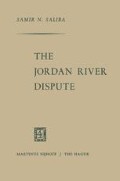Abstract
A simple fact fundamental to river development everywhere is that “rivers ignore political boundaries, that watersheds are not defined by political lines.”1 This fact, which the Unified Plan tried to realize, was ignored by the states involved in the Jordan River dispute. Instead of exploiting the river on a regional basis, each of these states has preferred to go it alone on whatever portion of the river happens to lie within or along its borders. The result has been tragic, not only in the fact that such an approach is inefficient and uneconomical, but also and perhaps more important, because such action has the potential of precipitating war between Israel and the Arabs. For Israel is already diverting the head waters of the Jordan. The Arabs partly for purely economic reasons, but mostly for purposes of retaliation, have diverted, or are in the process of diverting, the sources of the Jordan, an action which could force Israel into attacking Arab installations and thus lead to war with the Arabs. Under such circumstances, a peaceful solution of the dispute is imperative.
Access this chapter
Tax calculation will be finalised at checkout
Purchases are for personal use only
Preview
Unable to display preview. Download preview PDF.
References
Eric Johnston, “The Problem of Water: A Key to the Future in the Middle East,” New York Times, October 19, 1958. For a similar view see: Lepawsky, op.cit., pp. 533 ff.
Georgiana G. Stevens,Jordan River Partition, Hoover Institution Studies No. 6 (Stanford: The Hoover Institution on War, Revolution, and Peace, 1965), p. 84.
Henry A Byroade, Asst. Secretary for Near Eastern, South Asian, and African Affairs, “Facing Realities in the Arab-Israeli Dispute,” Department of State Bulletin, Vol. 30, Nos. 758–783 (Jan.-June 1954), P. 722. It is estimated that the total number of Jews in the world is close to 10.3 million. For reference see Safran, op. cit., p. 82.
Gamal Abdul Nasser, President of the United Arab Republic, in an interview with the publisher of Blitz, an Indian weekly magazine, reprinted in Arab News and Views, Vol. 10, No. 3 (March 1964), p. 1.
Rights and permissions
Copyright information
© 1968 Martinus Nijhoff, The Hague, Netherlands
About this chapter
Cite this chapter
Saliba, S.N. (1968). Prospects. In: The Jordan River Dispute. Springer, Dordrecht. https://doi.org/10.1007/978-94-015-0979-4_8
Download citation
DOI: https://doi.org/10.1007/978-94-015-0979-4_8
Publisher Name: Springer, Dordrecht
Print ISBN: 978-94-015-0387-7
Online ISBN: 978-94-015-0979-4
eBook Packages: Springer Book Archive

